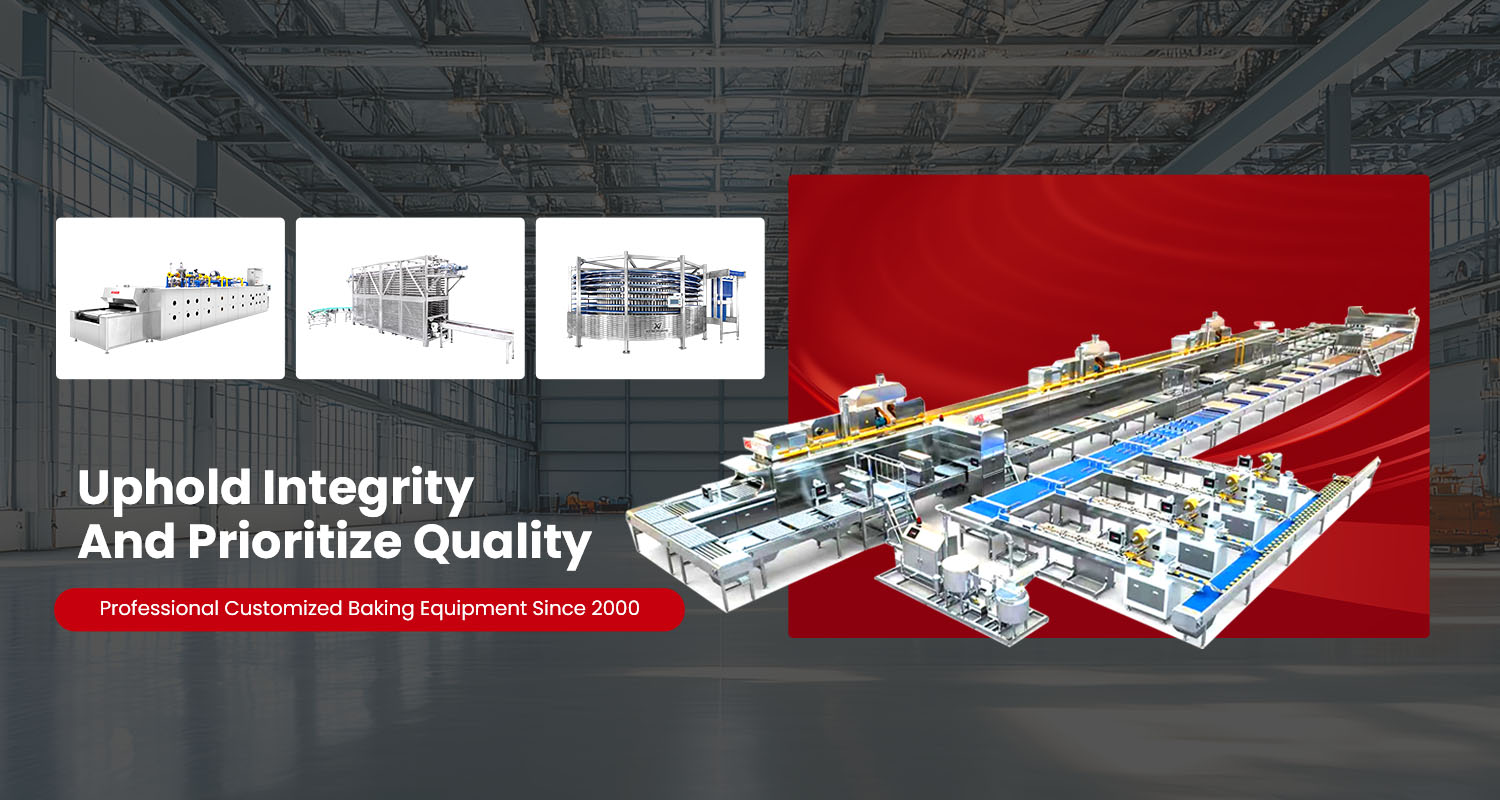What Safety Standards Apply to Bakery Machinery?
In the baking industry, ensuring the safety of machinery is critical—both for protecting workers and maintaining equipment that meets hygiene, food-contact and operational reliability requirements. This article outlines the key safety standards that apply to bakery machinery, describes how they intersect across regions, and offers guidance on how manufacturers and users can ensure compliance and safe operation. We also briefly introduce the company KC‑SMART as a supplier that addresses compliance in its bakery equipment offerings.
1. Scope of machinery safety in bakeries
Bakery machinery includes equipment such as mixers, sheeters, ovens, depanners, conveyors, cooling towers, sorters and other automatic lines. Given the mixture of food-processing, mechanical movement, high temperatures, rotating parts and often combustible dust (such as flour), the safety regime must cover:
Mechanical hazards (moving parts, gears, belts)
Thermal hazards (hot surfaces, ovens)
Electrical hazards (control circuits, motors)
Hygiene and food-contact safety
Combustible-dust and fire hazards
Ergonomics and worker-interaction design
Thus, safety standards for bakery machinery must address both general machine safety (mechanical, electrical) and the sector-specific issues relevant for food production. For example, the U.S. regulation 29 CFR 1910.263 applies specifically to bakery equipment: “The requirements of this section shall apply to the design, installation, operation and maintenance of machinery and equipment used within a bakery.”
2. Key U.S. standards and regulations
2.1 OSHA regulation 29 CFR 1910.263 – Bakery Equipment
This part of the U.S. occupational safety regulation details requirements such as machine guarding, enclosure of gears and sprockets, lubrication access, insulation of hot surfaces, and more. For example: “All gears shall be completely enclosed regardless of location.” It is therefore one of the baseline minimum requirements for machinery used in bakeries in the U.S.
2.2 ANSI Z50 Standards – Bakery Equipment Safety & Sanitation
The American National Standards Institute (ANSI) supports two standards relevant to bakery equipment:
ANSI Z50.1: Safety Requirements for Bakery Equipment – covering operator protection, machine guards, control systems etc.
ANSI Z50.2: Sanitation Requirements for Bakery Equipment – focusing on hygienic design, cleanability, surfaces etc.
These standards are voluntary but represent accepted best practices within the U.S. bakery-equipment manufacturing industry.
2.3 Other relevant U.S. considerations
Combustible dust: The bakery environment often contains flour dust, sugar dust and other fine particles, which pose fire/explosion risk. The OSHA guide highlights that flour storage bins must be dust-tight and static electricity mitigated.
Electrical & structural maintenance: While not unique to bakery equipment, standards such as those from the National Fire Protection Association (e.g., NFPA 70B for electrical equipment maintenance) may apply.
Here is a quick summary of U.S.-relevant standards:
| Standard / Regulation | Scope | Applicability |
|---|---|---|
| 29 CFR 1910.263 | Bakery equipment – guarding, installation | All bakery equipment in U.S. industry |
| ANSI Z50.1 | Safety design for bakery equipment | Manufacturers & users choosing best practice |
| ANSI Z50.2 | Sanitation design for bakery equipment | Hygienic design & food-contact equipment |
| NFPA 70B (electrical) | Electrical equipment maintenance | Electrical safety maintenance |
3. European / International harmonised standards
For machinery supplied into the European Economic Area (EEA) or globally, a number of international and European standards apply to bakery machinery. These standards form the technical backbone for compliance under directives and regulations.
3.1 Machinery Directive and CE marking
In the EU, machinery must comply with the Machinery Directive 2006/42/EC (and successor) which sets out essential health and safety requirements for machines. Compliance is demonstrated via harmonised standards.
3.2 Key Harmonised Standards
Important standards for bakery machinery include:
EN 60204‑1 (Safety of machinery – Electrical equipment of machines) — covers electrical safety, wiring and control.
EN ISO 13849‑1 / EN 62061 (Safety-related parts of control systems) — for design of safety functions like emergency stop, interlocks, and system reliability.
EN 746‑1/2 (Industrial thermoprocessing equipment) — especially relevant for ovens and gas-fired furnaces used in large-scale baking.
EN 1672‑2 (Food processing machinery – Basic concepts – Hygiene requirements) — addresses hygienic design for food machinery.
3.3 International functional safety and machinery control systems
In addition to the above, broader standards on functional safety also apply when bakery machinery uses complex electronics or control systems:
ISO 13849 (Safety of machinery – Safety-related parts of control systems) – covers safety functions of machine control systems.
IEC 61508 (Functional safety of electrical/electronic/programmable electronic safety-related systems) – generic foundation for safety systems across industries.
3.4 Hygiene and food-contact standards
Beyond mechanical/electrical safety, hygiene is essential. Standards such as the NSF International / American National Standards Institute standard set NSF/ANSI 2 (“Food Equipment”) cover food-handling equipment materials and design.
4. Practical checklist for bakery-machinery stakeholders
Whether you are purchasing, installing or operating bakery machinery, here is a practical checklist aligned with the standards described:
Machine design and guarding
Ensure moving parts (gears, belts, sprockets) are fully enclosed and inaccessible during operation.
Emergency-stop devices, interlocks and safety control circuits designed to match performance levels (ISO 13849/EN 62061).
Electrical equipment designed per EN 60204-1 (or equivalent).
Hygiene and food-contact design
Surfaces in contact with food must be smooth, washable, corrosion resistant.
Design must allow cleaning access and prevent contamination (EN 1672-2, ANSI Z50.2).
Components such as conveyors, mixers, ovens should support hygienic operation.
Hazardous dust / fire risk
If flour or sugar dust is present, install dust-control systems, ensure bins are sealed, static-electricity mitigation in place.
For gas-fired ovens or high-temperature equipment, check compliance with EN 746-2 or analogous standards.
Documentation and traceability
Manufacturer label with name/address, machine type, serial number, year of construction.
Declaration of Conformity detailing applicable directives/standards (for EU) or relevant certification (for U.S.).
Instruction manual and maintenance manual provided to operator.
Maintenance and operation
Lubrication access must allow safe servicing without reaching into dangerous parts.
Regular inspection of guards, controls, dust systems, electrical equipment.
Training of operators on safe use and cleaning procedures.
Installation and commissioning
Ensure machine installed per manufacturer instructions, including correct wiring, guarding, emergency stops.
Commission safety systems (interlocks, sensors) and verify performance.
Conduct risk assessment for particular bakery layout and process (manual handling, dust exposure, thermal hazards).
5. Linking standard compliance to intelligent bakery equipment
When selecting bakery equipment, it’s wise to choose suppliers who clearly address both safety and hygiene standards in their product design, manufacturing and documentation. For instance, the manufacturer KC-SMART emphasises one-stop solutions, custom design, manufacturing, installation, debugging and after-sales maintenance for baking food customers.
By choosing equipment from a supplier with strong technical capabilities, you improve your chances of meeting the safety and hygiene standard requirements described above. In particular, check whether the equipment is designed with machine guarding, hygienic materials, accessible cleaning, dust control, and documented conformity.
6. Summary
The safe use of bakery machinery demands compliance with multiple layers of standards: mechanical and electrical safety, hygiene and food-contact design, combustible-dust and fire hazards, and operational/maintenance procedures. In the U.S., 29 CFR 1910.263 and ANSI Z50 series are primary frameworks. In Europe and globally, the Machinery Directive, EN/ISO standards (EN 60204-1, EN ISO 13849‐1, EN 746-1/2, EN 1672-2) form the technical foundation.
A proactive approach involves selecting equipment built with compliance in mind, ensuring proper installation and training, and maintaining rigorous servicing and inspection regimes. Equipment suppliers such as KC-SMART can support this by providing machines tailored to bakery production with attention to safety and hygiene requirements.
By integrating these safety standards into your bakery machinery procurement, installation and operation processes, you protect your workforce, safeguard product quality, minimise downtime and reduce regulatory risk.






